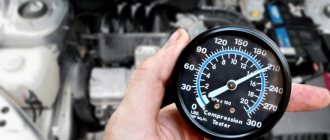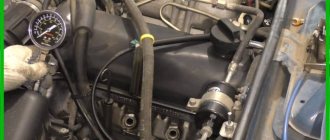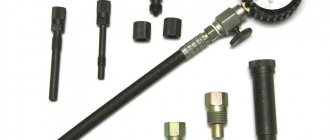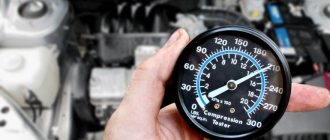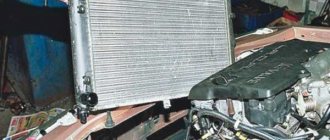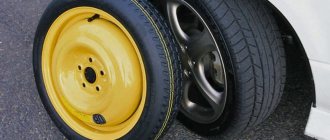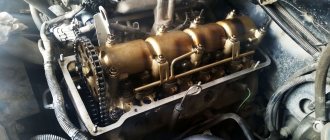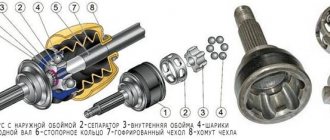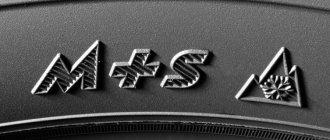Motorists operating VAZ 2121 cars and their modifications are often concerned about the question of what compression should be considered acceptable in a Niva. Such interest is understandable, because it is this indicator that characterizes the degree of wear of the elements of the piston group and the condition of the valves of the gas distribution mechanism. But getting an answer about pressure is only half the battle; then you need to effectively apply this knowledge to clarify faults in case of compression deviations from the norm.
To ensure that the compression test gives accurate results
Compression depends not only on the technical condition of the engine, but also on the conditions under which it is measured. Make sure that during the check:
- the compression gauge was working properly;
- the engine has been warmed up to operating temperature (up to 90 degrees);
- the throttle valve was fully open;
- spark plugs in all cylinders must be turned out;
- the starter was fully operational;
- the battery was fully charged;
- The engine air filter was clean.
Compression and compression ratio are the same thing: the first fairy tale
No not like this! Compression is the pressure in the cylinder, the compression ratio is a dimensionless parameter that describes the geometric parameters of the cylinder: it is the ratio of the total volume of the cylinder to the volume of the compression chamber (the compression chamber is the volume of space above the piston at its position at TDC (it is also called the volume of the end of compression - this is the same thing). Calling it a combustion chamber is incorrect, since fuel combustion occurs throughout the entire volume of the cylinder.) Compression depends on the compression ratio, but the compression ratio does not depend on compression! Compression also depends on a bunch of parameters: compression start pressure, valve timing adjustment, temperature at which the measurement is carried out, leaks from the combustion chamber. And leaks are determined by wear of the rings and cylinders.
“Compression” is the maximum pressure that we measure in the cylinder when the ignition is turned off.
Reasons why there is no compression in the cylinder
Poor (small) compression in one or all cylinders indicates engine wear. There is an old and simple way to determine why compression has disappeared. You need to pour a tablespoon of engine oil into the spark plug hole and repeat the measurements:
- if the pressure has increased noticeably, it means the piston rings have poor sealing;
- if the pressure has not changed, then there may be several reasons (for example, leaking valves, broken gaskets under the cylinder head, there is a crack or burnout in the walls of the combustion chamber, in the piston bottom).
There is another, more accurate way to find out why compression has disappeared. To do this, you will need to modify the spark plug. We remove the insulator from it, and weld the valve of the car camera to the metal body.
Next, set the cylinder piston to the ignition timing position, remove the radiator caps and oil filler neck, screw in the manufactured adapter and pump air into the cylinder using a pump (create pressure in it):
- if air enters the exhaust pipe, it means the exhaust valve is poorly sealed;
- If air goes into the intake manifold, there is a problem with the intake valve.
- if bubbles appear in the expansion tank, then check the cylinder head gasket;
- If there is a hissing sound in the oil filler neck, it means that the piston rings are not properly sealed.
Engine diagnostics using compression measurements in the cylinders allows you to quickly and accurately determine its condition without disassembling, and in some cases will help avoid major repairs of the power unit. Have you ever experienced a lack of pressure in the cylinders? What was the cause of the malfunction? If engine problems persist, check the fuel rail pressure.
Keywords: Lada Granta engine | Lada Kalina engine | Lada Kalina 2 engine | Lada Priora engine | Lada Largus engine | Niva engine | Lada Vesta engine | lada xray engine | universal article
00Found an error? Select it and press Ctrl Enter..
Chevrolet car repair manuals and tips
An engine compression test is performed to find faults in an internal combustion engine. Compression is the compression of the mixture in the cylinder under the influence of external forces. Compression is measured as the compression ratio multiplied by 1.3. When measuring compression, you can find a cylinder that is malfunctioning.
If the car has various kinds of problems, such as a drop in power, oil loss, or tripping in the engine, then check the spark plugs, sensors, and inspect the engine for damage and leaks. When such checks do not bring results, they resort to compression measurements.
You can check the compression yourself using a compression gauge. At service stations, such checks are done using a compressor or motor tester.
Engine compression can decrease for many reasons:
1. Wear of pistons and piston group parts 2. Incorrect timing adjustment 3. Burnout of valves and pistons.
To specifically determine the cause of the malfunction and measure engine compression. Let's figure out how to carry out this procedure.
Checking engine compression
First you need to prepare the engine for testing. To do this, we first need to warm up the engine to a high temperature of 70-90 degrees. After this, you need to turn off the fuel pump so that no fuel is supplied and remove the spark plugs.
Be sure to check the functionality of the starter and battery charging. The last step in preparation is to open the throttle and air valve.
After all this, we move directly to checking the compression:
1. Insert the tip of the compression gauge into the spark plug connector and use the starter to crank the engine until the pressure stops increasing. 2. The crankshaft should rotate at about 200 rpm. 3. If the engine is working properly, the compression should increase in a matter of seconds. If this happens for a long time, this is evidence of burnt out piston rings, if the pressure does not increase at all, then most likely the block gasket needs to be changed. Should the minimum pressure in a gasoline engine be 10 kg/cm? (in a diesel engine more than 20 kg/cm?). 4. After taking the readings, release the pressure by unscrewing the cap on the device. 5. Check all other cylinders in the same way.
There is another method of checking, which differs from the above in that engine oil is poured into the cylinder being tested. An increase in pressure indicates worn piston rings; if the pressure does not increase, then the reason is the cylinder head gasket, or there is a leak in the valves.
If the engine is in good working order, the compression in it should be from 9.5 to 10 atmospheres (gasoline engine), while in the cylinders it should differ by no more than an atmosphere.
You can also diagnose weak compression by the operation of the carburetor. If there is an air leak, check the fit of the bypass valve. If air leaks out of the top of the radiator, then a faulty cylinder head is to blame.
What affects engine compression
1. Throttle position. When the throttle is closed or covered, the pressure decreases 2. Air filter contamination 3. Incorrect valve timing when the valve closes and opens at the wrong moments. This happens when the belt or chain is installed incorrectly 4. The valves are not closed on time due to gaps in their drive. 5. Motor temperature. The higher its temperature, the higher the temperature of the mixture. Therefore, the pressure is lower. 6. Air leakage. Air leaks reduce compression. They are caused by damage or natural wear of the combustion chamber seals. 7. Oil entering the combustion chamber increases compression 8. If fuel enters in the form of drops, the compression decreases - the oil, which plays the role of a seal, is washed off 9. Lack of tightness in the compression gauge or in the check valve 10. Crankshaft rotation speed. The higher it is, the higher the compression, there will be no leaks due to leaks
Taking a measurement
Measurements of the compression value are carried out in each cylinder separately, and the power unit must be in a warm state. In a cold engine, the readings will be lower than actual ones, although in the presence of a glaring malfunction they will also be able to reflect the picture. To measure you will need the following tools and devices:
- spark plug key;
- a pressure gauge (otherwise known as a compression gauge) of a threaded or clamping type;
- rags.
A pressure compression gauge is a steel tube with a handle, at one end of which a rubber cone and valve are installed, and a pressure gauge is screwed to the other.
The device is inserted with a rubber cone into the threaded part of the cylinder and pressed using the handle. In this case, you cannot do without the services of an assistant who turns on the starter.
A pressure gauge with a hose and a thread at the end will have to be screwed into each hole one by one, but you can check it yourself. The procedure for performing measurements is as follows:
- Remove the high-voltage wires from the spark plugs and move them as far away as possible to avoid electric shock.
- Unscrew all spark plugs and wipe their seats with a rag. It is advisable to arrange them in the order of unscrewing, so that during diagnostics you can determine which cylinder the spark plug was removed from.
- Insert or screw the end of the device into the hole of cylinder 1 and turn on the starter for 3-6 seconds.
- Record the readings and move on to the next cylinder.
If for some reason the measurement did not work or you held the compression meter askew, the procedure must be repeated. Take your time to clean the spark plugs; their condition can tell a lot during the test analysis.
Why do you need to check?
It is recommended to measure compression at least once every 15-20 thousand kilometers. Its deviation to a lesser extent leads to the fact that the fuel mixture is not compressed to the required level and ignites at a slower rate, as a result of which the engine overheats and its power is significantly reduced.
Also interesting: Electric mirror joystick – Nivamart
Increased compression, on the contrary, causes early ignition of the mixture, as a result of which it detonates, creating additional loads on the piston elements.
If there is a difference in compression in the cylinders of one engine, the mixture will ignite at different rates, creating an imbalance in the coordinated operation of the pistons and camshaft(s).
Communities › Kulibin Club › Blog › 100 horses in Niva - for real! Increased efficiency
I thought for a long time about where to start the topic, it would probably be more correct to first write how I came to this. I was constantly tormented by the question - why does a car consume on average 10 liters of fuel, and a Niva - 15 liters? Why is the efficiency of an internal combustion engine so low? How can it be increased?
I liked physics since school; the Internet opened access to many materials and technical literature.
I’ll tell you the result of 8 years of work - 7 modified engines of different models. Engines modified using my method become 20-30% more powerful, while at the same time fuel consumption decreases by 10-20%. Efficiency increased - FACT.
Refinement work is carried out during an engine overhaul and, with the right approach to repairs, does not increase its cost at all. Intercapital mileage increases by 50 - 100 thousand km. There is a justification. I will write about everything in detail, since I have a lot of work to do.
Instructions for checking compression of VAZ-2109
To measure compression, you need to prepare special tools:
- a compression gauge consisting of a soft bendable hose, a pressure release key and a tip with a measurement panel;
- spark plug key.
When diagnosing yourself, you cannot do without an assistant. Instructions for measuring compression of a VAZ-2109 injector and carburetor look like this:
- Turn on the car engine and heat it to a temperature of 80 to 90 degrees.
- Remove the hose from the fuel pump that drains gasoline.
- Carefully unscrew the spark plugs, first clearing the wells of any build-up of dirt and debris.
- Remove the armor wire located in the center from the toggle switch cover, fix the spark plug in it and place it on top of the engine.
- Place the compressor tip in the recess of the first cylinder; the device does not have to be screwed in; it can be pressed against the hole with your hands.
- Proceed to measure pressure. The assistant must take the driver's seat and press the gas pedal all the way, then turn the key in the ignition and start the starter for at least 3-5 seconds.
- Watch how the compression meter values change at this time, the dynamics of increasing readings should be recorded, and also write down the maximum position of the arrow. Once locking is complete, release the pressure by pressing the release button.
- These actions must be performed for each engine cylinder separately, so as not to forget the indicators, record them on a piece of paper.
Fixing problems
In most cases, when the friction parts of the engine wear out, the pressure drops, although there is a malfunction in which the compression, on the contrary, increases. It is necessary to consider possible breakdowns in order, starting with the causes of low pressure:
- The piston rings are worn. Average engine oil consumption is observed (up to 300 g per 1000 km), and compression is uniformly reduced in all cylinders. To verify this, you can dump 5-7 g of oil inside, crank the crankshaft using the starter and repeat the measurement. If the pressure increases sharply by 2-3 bar, then the problem lies in the rings.
- I developed my resource for the entire piston group. Oil consumption is high. from 300 to 500 g per 1000 km, from the exhaust pipe. gray smoke, and on the candles. oil deposit. When the pressure is re-measured with the addition of oil, the index does not increase because the gaps between the walls of the engine friction parts are too large.
- The valves are poorly adjusted, in the jargon. jammed. If there is no gap between the tappet and the camshaft neck when cold, then when it heats up, the latter expands and opens the channel, it remains open. Because of this, compression can drop to zero and the cylinder does not work.
- The valves may be slightly open due to accumulated deposits on the pressure side. Then the pressure can also drop significantly. Typically, this situation is the result of oil entering the combustion chamber through worn rings. That is, when the cylinder head is removed, a complex fault occurs.
Sometimes in Niva cars, compression may disappear in 4 cylinders and noticeably decrease by 3: this is the result of engine overheating.
The fourth piston, as well as the furthest one from the cooling fan, significantly expanded and damaged the cylinder walls (burnt in the slang). The same thing happens with 3 pistons, although to a lesser extent.
Also interesting: To chip or not to chip a car engine
The engine runs poorly and smokes, oil consumption. up to 1 liter per 1000 km. Urgent need for major repairs.
Increased pressure
A paradoxical situation with increasing compression occurs when motor lubricant hits the piston rings from above, from the side of the combustion chamber. It seals the interface and when measured, the pressure jumps to 14-15 bar.
The reason is due to worn valve seals, which leak a lot of lubricant into the Niva’s combustion chamber. The exhaust smokes desperately, the oil consumption is high, but the pistons and rings have nothing to do with it. The problem is detected when the valve cover is opened and the clamps are removed from the valve tappets. Unusable caps have an “oak” feel to the touch or are covered with cracks. Oil seals can be changed without disassembling the power unit.
What does low compression lead to?
Most often, compression in the cylinders does not increase, but decreases. This may be a consequence:
- wear or damage to compression rings;
- wear or burnout of valves;
- damage to the cylinder head gasket;
- cracks in the cylinder head.
These problems can cause:
- reducing engine power;
- deterioration of dynamic performance;
- increased fuel consumption;
- “forcing” oil into the air filter housing (in carburetor engines);
- oil getting inside the combustion chambers (the engine “eats” oil, which is characterized by bluish exhaust smoke).
If you find the listed signs in your car, be prepared to at least replace the piston and, at maximum, overhaul the engine. But before you start repairing it, you should make sure that the compression is really low.
Advantages and disadvantages
The specified engine characteristics and its design have disadvantages:
- high noise during operation;
- very low service life;
- significant vibrations on the machine body;
- overheating of the engine in the urban cycle;
- high engine oil consumption.
As a result, frequent major repairs and an increased operating budget. The main advantages were:
- automatic chain tensioner;
- valve lifters;
All the problems of the classic series remain, however, with timely maintenance, the engine does not cause any special problems for the owner.
How else to determine the reduced pressure in the engine cylinders
If you have regular motor oil on hand, you can easily check the low compression on the VAZ-2109 by following this guide:
- Add 10 cubes of oil to the cylinder and measure the pressure again.
- If the readings of the measuring device have increased, the problems consist of rings that are stuck and wear of the cylinder-piston set.
- If the compression meter values remain at the same level, it means that the valve has burned out or the gasket adjacent to the cylinder head has been damaged.
How to get rid of stuck piston rings
If the fault is that the rings are stuck, to repair them, repeat the following steps:
- Warm up the VAZ-2109 engine.
- Find a spark plug hole in each cylinder and add 10 cm cubes there using a medical syringe or rubber bulb. a mass consisting of kerosene (occupies half of the total mass), acetone (a quarter of the volume), motor oil (a quarter of the volume).
- Set the mixture aside for 3-4 hours; if you have time and there is no hurry, it is better to leave it overnight.
- After this, rotate the starter for 10-15 seconds with the spark plugs turned out.
- All that remains is to drain the old oil, and after replacing the old filtration device, fill in the new one.
Now that you know what engine cylinder compression should be on a VAZ-2109 and how to determine it yourself, and most importantly, how to eliminate the detected faults, returning the car is not difficult.
How to get rid of inaccurate compression measurements
The compression meter may show inaccurate values if at least one of the following factors exists:
- VVAZ-2109 battery is practically not charged;
- a starter malfunction has been detected;
- the engine is cold;
- valve clearances do not correspond to normal values;
- gasoline got into the cylinders;
- The measurements were initially taken incorrectly.
In the absence of an assistant, the procedure was carried out without pressing the gas pedal, which in itself is considered a significant violation of pressure measurement.
Experts note that the compression meter gives increased readings when there is excess oil in the cylinders, this is due to wear of the oil scraper caps built to guide the VAZ-2109 or CPG valve bushings.
Regardless of which mechanism is installed in the VAZ-2109 - a carburetor or an injector - the maximum pressure value is calculated based on the product of the compression ratio and a constant coefficient equal to 1.2.
Compression Niva Chevrolet norm
For starters, I got stuck again) Frosts hit for a couple of days, then it warmed up again and it started snowing. And the snow became flaky like a pie. It’s soft near the ground, 20cm from the ground it’s hard (it doesn’t collapse under my weight) and another 10cm from above is still soft. As a result, when breaking through the next road, it sank to the ground and the wheels could not break through the hard layer; the rocking was not successful. I had to work with a shovel for about 20 minutes, digging out a place for swinging.
Despite all this, there is almost no snow, I hardly even row across bridges, 30 cm in total.
As soon as I cleared a little track under the wheels, I immediately drove out) I decided not to break through the road any further, well, why bother digging so much in one person)
And now the actual subject. I bought a compression gauge (700 rubles) a long time ago, but I couldn’t check everything in practice. And then I decided. I did everything according to science. I took out the spark plugs, put the pedal to the floor (I took off the knee sensor just in case) and let’s oil the starter and build up compression in the cylinders. And here are the results:
After the engine overheats, I still live in anticipation of its consequences. I drove about 1000 km, there is no oil consumption, it starts normally, the ECM does not give any errors. Today I measured the compression.
The first cylinder showed 10.6 at the first measurement, and reached this figure only by the 6th revolution of the CV. The remaining three cylinders showed 8 from the first revolution of the CV, and from the second third revolution they showed 11-11.4-11.4, respectively. during the second measurement, the first cylinder caught up with the others, 8 from the first revolution and 11 further. Total result 11-11-11.4-11.4
Motorists operating VAZ 2121 cars and their modifications are often concerned about the question of what compression should be considered acceptable in a Niva. Such interest is understandable, because it is this indicator that characterizes the degree of wear of the elements of the piston group and the condition of the valves of the gas distribution mechanism. But getting an answer about pressure is only half the battle; then you need to effectively apply this knowledge to clarify faults in case of compression deviations from the norm.
How to check it yourself
Having a compression gauge and an assistant at hand, measuring compression will not be difficult.
- Warm up the engine to operating temperature.
- Shut off the fuel supply to the cylinders. For carburetor engines, disconnect the hose that goes from the carburetor to the fuel pump; for injection engines, remove the fuel pump fuse and let the engine run until the fuel is used up from the system.
- Disconnect all high voltage wires from the spark plugs.
- Unscrew the first spark plug and insert the compression gauge fitting in its place.
- Have a helper run the starter for a few seconds until the pressure gauge needle stops moving up.
- Take pressure gauge readings and compare them with standard values.
- Carry out the same procedure for all cylinders. Compare the compression ratios in the cylinders.
Chevrolet Niva 2007, 78 l. With. — self-repair
Before taking measurements, warm up the engine to operating temperature. This creates optimal clearances between all moving parts. Apply the parking brake, place the gear shift in neutral, and press the clutch and accelerator pedals. When installing the compression tester, the rubber plug should tightly cover the spark plug hole 4. Insert the rubber plug of the compression tester tightly into the spark plug hole in the diesel engine - into the fuel injector hole.
If necessary, use a suitable adapter fig. Turn on the starter and rotate the crankshaft for at least eight compression strokes, monitoring the compression gauge readings. It must be borne in mind that the best filling of the cylinders occurs only when the accelerator pedal is fully depressed.
What are the cylinder compression standards for VAZ engines?
Engine specifications must indicate “minimum cylinder compression values.” If you cannot find such data, determine the compression standards yourself using the formula:
| Compression (kgf/cm2) = compression ratio (see technical specifications of internal combustion engine) * coefficient (for VAZ min 1.2, max 1.3) |
A few examples:
- The compression ratio of modern VAZ 21126 and VAZ 21127 engines installed on Granta, Kalina and Priora is 11. We multiply the values using the formula and get the compression standards: 13.2..14.3.
- For the Vesta engine (VAZ-21129) the compression ratio is 10.45, the compression standards will be: 12.5..13.6.
- For Niva (VAZ 21213, 21314) - 11.3..12.2.
Also interesting: Water got into the Niva’s gas tank - what should I do?
If the compression gauge values in all cylinders are within the normal range, this does not mean that everything is fine. Different compression in the cylinders is also bad. It is important that the difference between all readings is minimal. Compare the minimum and maximum compression values in the cylinders. According to technical standards, the difference should be no more than 1 kgf/cm2 or 10%.
Increased compression - increased power: the second fairy tale
Not certainly in that way. Compression can be increased in two ways - increasing the compression ratio or reducing leaks from the combustion chamber. Let's see what happens in each case: we have a stand at our disposal.
First, let's reduce the volume of the compression chamber. The easiest way to do this is to grind the bottom plane of the cylinder head. The base engine of the “eleventh” VAZ has a cylinder displacement of slightly more than 370 cubic meters. With a standard compression ratio of 9.8, the volume of the compression chamber will be 42.6 cm³. You can calculate that by removing 2 mm from the seating surface of the cylinder head, we reduce the volume of the compression chamber by 5.1 cm³. The new compression ratio will be 11 units, that is, 1.2 higher than that of the base engine. Now, just out of interest, let's remove another 2 mm. The compression ratio increases to 12.6. In the textbook we find the required formula and get: the thermal efficiency of the piston engine cycle should theoretically increase in the first case by at least 4%, in the second - by 9%. Great!
Now we put these heads on the bench motor and take the torque characteristics. The reduction in fuel consumption is significantly less than the theory promised - by 2.5% in the first case and by 4.5% in the second. Moreover, the effect is more pronounced in the zone of low loads. The increase in power is even less: 2–3% at most, and in the low and medium speed zone. And at high levels there is no effect.
Everything is clear: with an increase in the compression ratio, the pressure in the cylinder increases sharply, this increase provokes detonation, the corresponding sensor catches it and shifts the ignition timing back. Consequently, the power drops. And therefore the theoretical effect is significantly reduced. But the exhaust temperatures increase, which means that the risk of burning valves and pistons with such an engine is much higher.
The second method is to reduce leaks. Let's start from the opposite: let's compare what will happen to the torque characteristic if we replace the rings so that the gaps in them become, say, twice as large.
Done. For a new engine everything is fine, compression is 13.2 for all cylinders. 13.4 bar. For one damaged by rings with large gaps - 10.8. 11.1. What did the power measurements show? In the low speed zone, the power of the damaged motor dropped slightly, but when we reached 2500 rpm, the torque curves almost merged. This is because leaks from the combustion chamber into the crankcase, which should reduce power, are noticeable only at low speeds, and at high speeds their mass per cycle drops sharply, because with a decrease in cycle time and an increase in crankshaft rotation speed, the time for leakage also decreases .
Compression increased sharply, but power did not. Along with compression, detonation arose, and the ignition timing had to be shifted back. And it affects the power more.
What should the compression be in VAZ cars?
The average compression rate for unboosted VAZ engines is 8-9 atmospheres, for forced ones with a reduced combustion chamber - 11-13 atmospheres.
In order to accurately determine the standard compression ratio, use the table that indicates the compression ratio in the cylinders of eight- and sixteen-valve VAZ engines.
| Number of valves | 16 | 16 | 8 | |
| Engine volume, l | 1,5 | 1,6 | 1,5 | 1,6 |
| Cylinder diameter/piston stroke, mm | 82/71 | 82/75,6 | 82/71 | 82/75,6 |
| Compression ratio | 10,5 | 10,3 | 9,9 | 9,6 |
Troubleshooting
In most cases, when the rubbing parts of the engine wear out, the pressure decreases, although there is a malfunction in which the compression, on the contrary, increases. It is necessary to consider possible breakdowns in order, starting from the causes of low pressure:
- The piston rings are worn out. Average engine oil consumption is observed (up to 300 g per 1000 km), and compression decreases evenly in all cylinders. To verify this, you can drop 5-7 g of oil inside, crank the crankshaft with the starter and repeat the measurement. If the pressure increases sharply by 2-3 bar, then the problem is in the rings.
- The entire piston group has exhausted its service life. Oil consumption is high - from 300 to 500 g per 1000 km, blue smoke is noticeable from the exhaust pipe, and oil deposits are present on the spark plugs. When the pressure is measured again with the addition of oil, the indicator does not increase, since the gaps between the walls of the rubbing parts of the engine are too large.
- The valves are poorly adjusted, in the jargon they are clamped. If there is no gap between the valve tappet and the camshaft journal when cold, then when heated, the latter expands and opens the channel slightly, it remains constantly open. Because of this, compression may drop to zero and the cylinder will fail.
- The valves may be slightly open due to accumulated carbon deposits on the working part. Then the pressure can also drop significantly. Typically, this situation is the result of oil entering the combustion chamber through worn rings. That is, the malfunction is complex and is detected when the cylinder head is removed.
Sometimes in Niva cars, compression can disappear in cylinder 4 and decrease noticeably in cylinder 3: this is the result of engine overheating.
The fourth piston, being the farthest from the cooling fan, expanded greatly and damaged the cylinder walls (in jargon, it burned out). The same thing happens with piston 3, although to a lesser extent.
The engine runs poorly and smokes, oil consumption is up to 1 liter per 1000 km. Major repairs are urgently needed.
And it’s not a fairy tale at all.
So what does compression do? For a lot! The main thing is the starting properties of the motor, especially at low temperatures.
This primarily applies to diesel engines, where the pressure and temperature at the end of compression determine whether the fuel in the cylinder will ignite or not. But gasoline engines in a cold state are also sensitive to changes in compression: it affects the volatility of the fuel, which, during a cold start, should only theoretically evaporate on the way to the cylinder. But in reality, it gets there in the form of non-flammable liquid drops.
Reduced compression increases crankcase gas pressure. In this case, a larger volume of oil vapor flies through the ventilation system to the engine inlet. This is bad: toxicity increases, and the rate of combustion chamber contamination increases sharply.
Uneven compression across the cylinders causes engine vibrations, especially noticeable at idle and at low speeds. And this, in turn, harms both the transmission and the engine suspension. And to the driver himself.
In short, the role of compression as a diagnostic sign, largely characterizing the condition of the engine, is very great. And our “fairy tales” in no way call for giving up on her - on the contrary! But the desire for an unbridled increase in it in search of additional “horses” is generally futile.
Reasons for low pressure in the cylinders of the VAZ-2109 engine
Air compression will show why the pressure is low. To determine the compression stroke in a specific cylindrical device, place a thin and long screwdriver in the spark plug hole; you can replace it with a regular stick or a piece of wire. Hold the screwdriver with your hand and lower it directly onto the piston bottom.
When the air is compressed, the screwdriver comes out of the spark plug hole, following the direction from bottom to top. Your task is to determine the moment when the upward movement stops and changes into a downward movement following the piston; this is the intake stroke - the starting point of the piston movement and the end of the compression stroke.
Next, insert the hose coming from the compressor into the recess of the spark plug and transfer the air flow into the cylindrical structure, pumping up pressure from 2 to 3 atmospheres. The malfunction of the unit is determined by where the air comes from:
- If air leaks through the adjacent recess into the spark plugs or appears in the expansion tank, it means the head gasket has burned out.
- If the air flow comes out of the carburetor, the intake valve may be burnt out, and there is also the possibility of poor valve adjustment.
- Air coming out of the muffler also indicates a burnt out exhaust valve or poor regulation.
- If the air flow is directed from the breather, it can be assumed that the rings and pistons are worn.
How to measure compression in cylinders
A device for checking compression in cylinders is called a compression gauge. There are many varieties of them, but the differences between them are only constructive. Great for self-diagnosis.
At service stations you can find more complex devices that use a recorder instead of a dial pressure gauge that records the compression on a form or display.
Read news about the new Niva
- Niva winches - buy in Tyumen at a good price
- The design of the injection engine Niva 2121, Niva 2131
- What to choose Chevrolet Niva or UAZ Patriot
- The best crossovers by price and quality in 2022 in Russia: rating and review of models
- Electrical diagram of Chevrolet Niva 2123
- How to choose a flatbed trailer?
- Is it possible to change the wheels on a four-wheel drive vehicle? How often and in what order
- How to properly perform chip tuning of a Niva engine
